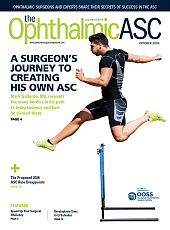Complement inhibition therapy slowed geographic atrophy (GA) progression by nearly 50% in patients with existing neovascular (“wet”) age-related macular degeneration (nAMD), without increasing neovascular activity, according to findings presented at the 2025 ASRS annual meeting in Long Beach, California.
Josh O. Wallsh, MD, of the Retina Macula Institute in Torrance, California, presented data from a retrospective review of 33 eyes treated with either pegcetacoplan (Syfovre; Apellis Pharmaceuticals) or avacincaptad pegol (Izervay; Astellas Pharma). Dr. Wallsh, a principal investigator for Astellas, noted that the pivotal trials for these agents excluded patients with concurrent nAMD. “We hypothesized, however, that such cases … would benefit from complement inhibition without any deleterious side effects,” he said. The review study focused on eyes diagnosed with nAMD prior to initiating complement therapy and relied on optical coherence tomography (OCT) fundus imaging to track lesion size and growth over time.
According to a linear regression analysis, Dr. Wallsh reported that the post-treatment growth rate of GA was significantly reduced compared to the pretreatment period. The annual rate of GA lesion growth declined from 1.5 mm² prior to complement inhibition treatment to 0.8 mm² following treatment initiation, he said. This reduction was consistent across patients, regardless of whether pegcetacoplan or avacincaptad pegol was used.
Secondary outcomes assessed choroidal neovascularization (CNV) activity via OCT indicators, such as new intraretinal or subretinal fluid or increases in macular thickness, as well as changes in anti-VEGF treatment regimens. Seven eyes switched anti-VEGF agents (primarily from bevacizumab) during the study, often to extend treatment intervals. After complement therapy initiation, the average interval between anti-VEGF injections increased, with only 1 patient requiring a shortened interval due to increased disease activity.
Only 4 eyes in the cohort showed any new signs of CNV activity, and in just 1 case did this require an alteration in therapy. Visual acuity, measured via logMAR, remained largely stable over the 1-year follow-up, with no statistically significant decline.
“So, what do we take away from all of this?” said Dr. Wallsh. “Complement inhibition is effective in patients with GA and wet AMD. Wet AMD is not negatively impacted by complement inhibition. And as a community, we can feel comfortable starting patients on complement inhibition if they already have the diagnosis of wet AMD.” RP








